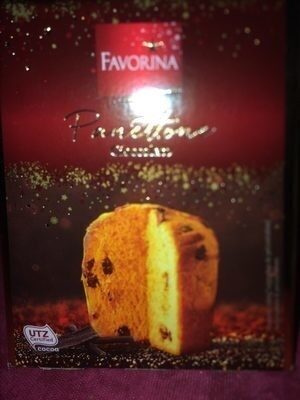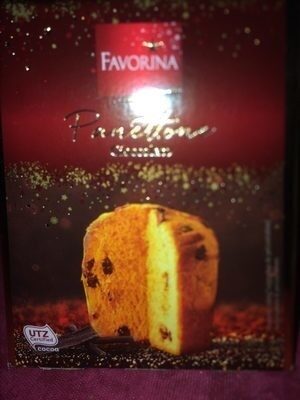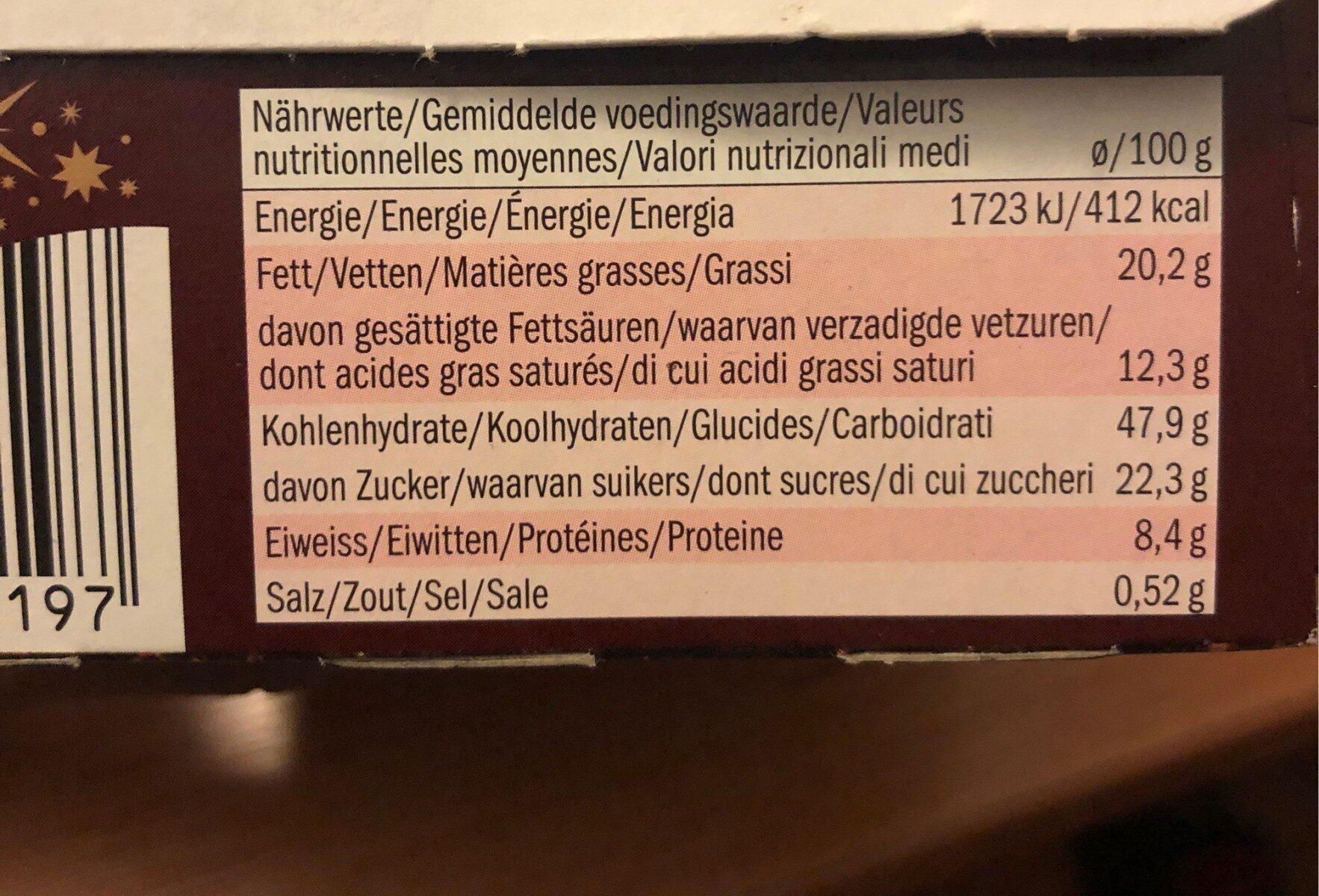Help us make food transparency the norm!
As a non-profit organization, we depend on your donations to continue informing consumers around the world about what they eat.
The food revolution starts with you!
Panettone Cioccolato - Favorina - 100 g e
Panettone Cioccolato - Favorina - 100 g e
Ambiguous barcode: This product has a Restricted Circulation Number barcode for products within a company. This means that different producers and stores can use the same barcode for different products.
×
This product page is not complete. You can help to complete it by editing it and adding more data from the photos we have, or by taking more photos using the app for Android or iPhone/iPad. Thank you!
×
Barcode: 20470197
Quantity: 100 g e
Packaging: Plastic, Box, Cardboard, Card-box, Pp film-sleeve
Brands: Favorina
Brand owner: FAVORINA
Categories: Snacks, Desserts, Sweet snacks, Biscuits and cakes, Sweet pastries and pies, Cakes, Viennoiseries, Brioches, Chocolate cakes, Panettone
Labels, certifications, awards:
Fair trade, Fairtrade International, Sustainable farming, UTZ Certified, UTZ Certified Cocoa

Stores: Lidl
Countries where sold: France, United States
Matching with your preferences
Health
Ingredients
-
19 ingredients
Wheat flour, eggs, chocolate chips (sugar, chocolate liquor, cocoa butter, soy lecithin, artificial flavors), sugar, butterfat, yeast preparation (wheat, sourdough starter, water), mono - and diglycerides of fatty acids, salt, skim milk, artificial flavors.Allergens: Eggs, Gluten, Milk, SoybeansTraces: Nuts
Food processing
-
Ultra processed foods
Elements that indicate the product is in the 4 - Ultra processed food and drink products group:
- Additive: E322 - Lecithins
- Additive: E471 - Mono- and diglycerides of fatty acids
- Ingredient: Emulsifier
- Ingredient: Flavouring
Food products are classified into 4 groups according to their degree of processing:
- Unprocessed or minimally processed foods
- Processed culinary ingredients
- Processed foods
- Ultra processed foods
The determination of the group is based on the category of the product and on the ingredients it contains.
Additives
-
E322 - Lecithins
Lecithins are natural compounds commonly used in the food industry as emulsifiers and stabilizers.
Extracted from sources like soybeans and eggs, lecithins consist of phospholipids that enhance the mixing of oil and water, ensuring smooth textures in various products like chocolates, dressings, and baked goods.
They do not present any known health risks.
-
E322i - Lecithin
Lecithins are natural compounds commonly used in the food industry as emulsifiers and stabilizers.
Extracted from sources like soybeans and eggs, lecithins consist of phospholipids that enhance the mixing of oil and water, ensuring smooth textures in various products like chocolates, dressings, and baked goods.
They do not present any known health risks.
-
E471 - Mono- and diglycerides of fatty acids
Mono- and diglycerides of fatty acids (E471), are food additives commonly used as emulsifiers in various processed foods.
These compounds consist of glycerol molecules linked to one or two fatty acid chains, which help stabilize and blend water and oil-based ingredients. E471 enhances the texture and shelf life of products like margarine, baked goods, and ice cream, ensuring a smooth and consistent texture.
It is generally considered safe for consumption within established regulatory limits.
Ingredients analysis
-
May contain palm oil
Ingredients that may contain palm oil: E471
-
Non-vegan
Non-vegan ingredients: Egg, Butter, Skimmed milk powderSome ingredients could not be recognized.
We need your help!
You can help us recognize more ingredients and better analyze the list of ingredients for this product and others:
- Edit this product page to correct spelling mistakes in the ingredients list, and/or to remove ingredients in other languages and sentences that are not related to the ingredients.
- Add new entries, synonyms or translations to our multilingual lists of ingredients, ingredient processing methods, and labels.
If you would like to help, join the #ingredients channel on our Slack discussion space and/or learn about ingredients analysis on our wiki. Thank you!
-
Vegetarian status unknown
Unrecognized ingredients: fr:lecithines-de-soja-aromes, fr:preparation-de-levain, fr:ferments-lactiques-levureSome ingredients could not be recognized.
We need your help!
You can help us recognize more ingredients and better analyze the list of ingredients for this product and others:
- Edit this product page to correct spelling mistakes in the ingredients list, and/or to remove ingredients in other languages and sentences that are not related to the ingredients.
- Add new entries, synonyms or translations to our multilingual lists of ingredients, ingredient processing methods, and labels.
If you would like to help, join the #ingredients channel on our Slack discussion space and/or learn about ingredients analysis on our wiki. Thank you!
-
Details of the analysis of the ingredients
We need your help!
Some ingredients could not be recognized.
We need your help!
You can help us recognize more ingredients and better analyze the list of ingredients for this product and others:
- Edit this product page to correct spelling mistakes in the ingredients list, and/or to remove ingredients in other languages and sentences that are not related to the ingredients.
- Add new entries, synonyms or translations to our multilingual lists of ingredients, ingredient processing methods, and labels.
If you would like to help, join the #ingredients channel on our Slack discussion space and/or learn about ingredients analysis on our wiki. Thank you!
fr: Farine de blé, œuf 20.8%, pépites de chocolat 14% (sucre, pâte de cacao, beurre de cacao, émulsifiant (lécithines de soja arômes)), sucre, beurre, préparation de levain (farine de blé, eau, ferments lactiques levure), émulsifiant (mono- et diglycérides d'acides gras), sel de cuisine, lait écrémé en poudre, arômes- Farine de blé -> en:wheat-flour - vegan: yes - vegetarian: yes - ciqual_proxy_food_code: 9410 - percent_min: 20.8 - percent_max: 65.2
- œuf -> en:egg - vegan: no - vegetarian: yes - ciqual_food_code: 22000 - percent_min: 20.8 - percent: 20.8 - percent_max: 20.8
- pépites de chocolat -> en:chocolate-chunk - vegan: maybe - vegetarian: yes - ciqual_proxy_food_code: 31005 - percent_min: 14 - percent: 14 - percent_max: 14
- sucre -> en:sugar - vegan: yes - vegetarian: yes - ciqual_proxy_food_code: 31016 - percent_min: 3.5 - percent_max: 14
- pâte de cacao -> en:cocoa-paste - vegan: yes - vegetarian: yes - ciqual_proxy_food_code: 16030 - percent_min: 0 - percent_max: 7
- beurre de cacao -> en:cocoa-butter - vegan: yes - vegetarian: yes - ciqual_food_code: 16030 - percent_min: 0 - percent_max: 4.66666666666667
- émulsifiant -> en:emulsifier - percent_min: 0 - percent_max: 3.5
- lécithines de soja arômes -> fr:lecithines-de-soja-aromes - percent_min: 0 - percent_max: 3.5
- sucre -> en:sugar - vegan: yes - vegetarian: yes - ciqual_proxy_food_code: 31016 - percent_min: 0 - percent_max: 14
- beurre -> en:butter - vegan: no - vegetarian: yes - ciqual_proxy_food_code: 16400 - percent_min: 0 - percent_max: 14
- préparation de levain -> fr:preparation-de-levain - percent_min: 0 - percent_max: 14
- farine de blé -> en:wheat-flour - vegan: yes - vegetarian: yes - ciqual_proxy_food_code: 9410 - percent_min: 0 - percent_max: 14
- eau -> en:water - vegan: yes - vegetarian: yes - ciqual_food_code: 18066 - percent_min: 0 - percent_max: 7
- ferments lactiques levure -> fr:ferments-lactiques-levure - percent_min: 0 - percent_max: 4.66666666666667
- émulsifiant -> en:emulsifier - percent_min: 0 - percent_max: 11.68
- mono- et diglycérides d'acides gras -> en:e471 - vegan: maybe - vegetarian: maybe - from_palm_oil: maybe - percent_min: 0 - percent_max: 11.68
- sel de cuisine -> en:salt - vegan: yes - vegetarian: yes - ciqual_food_code: 11058 - percent_min: 0 - percent_max: 0
- lait écrémé en poudre -> en:skimmed-milk-powder - vegan: no - vegetarian: yes - ciqual_food_code: 19054 - percent_min: 0 - percent_max: 0
- arômes -> en:flavouring - vegan: maybe - vegetarian: maybe - percent_min: 0 - percent_max: 0
Nutrition
-
Poor nutritional quality
⚠ ️Warning: the amount of fruits, vegetables and nuts is not specified on the label, it was estimated from the list of ingredients: 0This product is not considered a beverage for the calculation of the Nutri-Score.
Positive points: 2
- Proteins: 5 / 5 (value: 8.4, rounded value: 8.4)
- Fiber: 2 / 5 (value: 2.1, rounded value: 2.1)
- Fruits, vegetables, nuts, and colza/walnut/olive oils: 0 / 5 (value: 0, rounded value: 0)
Negative points: 19
- Energy: 5 / 10 (value: 1723, rounded value: 1723)
- Sugars: 4 / 10 (value: 22.3, rounded value: 22.3)
- Saturated fat: 10 / 10 (value: 12.3, rounded value: 12.3)
- Sodium: 0 / 10 (value: 0, rounded value: 0)
The points for proteins are not counted because the negative points are greater or equal to 11.
Nutritional score: (19 - 2)
Nutri-Score:
-
Nutrient levels
-
Fat in high quantity (20.2%)
What you need to know- A high consumption of fat, especially saturated fats, can raise cholesterol, which increases the risk of heart diseases.
Recommendation: Limit the consumption of fat and saturated fat- Choose products with lower fat and saturated fat content.
-
Saturated fat in high quantity (12.3%)
What you need to know- A high consumption of fat, especially saturated fats, can raise cholesterol, which increases the risk of heart diseases.
Recommendation: Limit the consumption of fat and saturated fat- Choose products with lower fat and saturated fat content.
-
Sugars in high quantity (22.3%)
What you need to know- A high consumption of sugar can cause weight gain and tooth decay. It also augments the risk of type 2 diabetes and cardio-vascular diseases.
Recommendation: Limit the consumption of sugar and sugary drinks- Sugary drinks (such as sodas, fruit beverages, and fruit juices and nectars) should be limited as much as possible (no more than 1 glass a day).
- Choose products with lower sugar content and reduce the consumption of products with added sugars.
-
Salt in low quantity (0%)
What you need to know- A high consumption of salt (or sodium) can cause raised blood pressure, which can increase the risk of heart disease and stroke.
- Many people who have high blood pressure do not know it, as there are often no symptoms.
- Most people consume too much salt (on average 9 to 12 grams per day), around twice the recommended maximum level of intake.
Recommendation: Limit the consumption of salt and salted food- Reduce the quantity of salt used when cooking, and don't salt again at the table.
- Limit the consumption of salty snacks and choose products with lower salt content.
-
-
Nutrition facts
Nutrition facts As sold
for 100 g / 100 mlAs sold
per serving (1 LOAF (100 g))Compared to: Panettone Energy 1,723 kj
(412 kcal)1,720 kj
(412 kcal)+11% Fat 20.2 g 20.2 g +36% Saturated fat 12.3 g 12.3 g +46% Trans fat 0.5 g 0.5 g Cholesterol 110 mg 110 mg - Salt 0 g 0 g -100% Carbohydrates 47.9 g 47.9 g -8% Fiber 2.1 g 2.1 g +3% Sugars 22.3 g 22.3 g -9% Proteins 8.4 g 8.4 g +26% Calcium 20 mg 20 mg -55% Iron 1.44 mg 1.44 mg -14% Potassium 70 mg 70 mg Fruits‚ vegetables‚ nuts and rapeseed‚ walnut and olive oils (estimate from ingredients list analysis) 0 % 0 %
Environment
-
Eco-Score C - Moderate environmental impact
The Eco-Score is an experimental score that summarizes the environmental impacts of food products.→ The Eco-Score was initially developped for France and it is being extended to other European countries. The Eco-Score formula is subject to change as it is regularly improved to make it more precise and better suited to each country.Life cycle analysis
-
Average impact of products of the same category: C (Score: 47/100)
Category: Chocolate cake
Category: Chocolate cake
- PEF environmental score: 0.60 (the lower the score, the lower the impact)
- including impact on climate change: 7.88 kg CO2 eq/kg of product
Stage Impact Agriculture
48.2 %Processing
45.1 %Packaging
3.2 %Transportation
2.7 %Distribution
0.8 %Consumption
0.0 %
Bonuses and maluses
-
Labels with very high environmental benefits
Bonus: +20
-
Fairtrade International
Fair trade is an arrangement designed to help producers in developing countries achieve sustainable and equitable trade relationships. Members of the fair trade movement add the payment of higher prices to exporters, as well as improved social and environmental standards.
-
-
Missing origins of ingredients information
Malus: -5
⚠ ️ The origins of the ingredients of this product are not indicated.
If they are indicated on the packaging, you can modify the product sheet and add them.
If you are the manufacturer of this product, you can send us the information with our free platform for producers.
-
Packaging with a high impact
Malus: -15
Shape Material Recycling Impact Sleeve PP 5 - Polypropylene High Box Unknown High ⚠ ️ The information about the packaging of this product is not sufficiently precise (exact shapes and materials of all components of the packaging).⚠ ️ For a more precise calculation of the Eco-Score, you can modify the product page and add them.
If you are the manufacturer of this product, you can send us the information with our free platform for producers.
Eco-Score for this product
-
Impact for this product: C (Score: 47/100)
Product: Panettone Cioccolato - Favorina - 100 g e
Life cycle analysis score: 47
Sum of bonuses and maluses: 0
Final score: 47/100
-
Carbon footprint
-
Equal to driving 4.1 km in a petrol car
788 g CO² per 100g of product
The carbon emission figure comes from ADEME's Agribalyse database, for the category: Chocolate cake (Source: ADEME Agribalyse Database)
Stage Impact Agriculture
30.6 %Processing
63.3 %Packaging
3.7 %Transportation
2.2 %Distribution
0.2 %Consumption
0.0 %
Packaging
-
Packaging with a high impact
-
Packaging parts
Sleeve (PP 5 - Polypropylene)
Box
-
Packaging materials
Material % Packaging weight Packaging weight per 100 g of product Plastic
-
Transportation
-
Origins of ingredients
Missing origins of ingredients information
⚠ ️ The origins of the ingredients of this product are not indicated.
If they are indicated on the packaging, you can modify the product sheet and add them.
If you are the manufacturer of this product, you can send us the information with our free platform for producers.Add the origins of ingredients for this product Add the origins of ingredients for this product
Labels
-
Fairtrade International
Fair trade is an arrangement designed to help producers in developing countries achieve sustainable and equitable trade relationships. Members of the fair trade movement add the payment of higher prices to exporters, as well as improved social and environmental standards.
Report a problem
-
Incomplete or incorrect information?
Category, labels, ingredients, allergens, nutritional information, photos etc.
If the information does not match the information on the packaging, please complete or correct it. Open Food Facts is a collaborative database, and every contribution is useful for all.
Data sources
Product added on by openfoodfacts-contributors
Last edit of product page on by roboto-app.
Product page also edited by beniben, bertrand-amaraggi, ci94, ecoscore-impact-estimator, elcoco, kiliweb, musarana, org-database-usda, packbot, quechoisir, segundo, swipe-studio, tacite, yuka.Yi9vT0FZYzcvL0FnbzhJdThRM3ArK2t0bUszNVFVaU9lc1l3SVE9PQ, yuka.Zi9rdVA0Y0l1c0EzbThJdjdoUFUwUHhVekxDSlFscTNLZWMvSUE9PQ, yuka.sY2b0xO6T85zoF3NwEKvllJ2d-KEoSPlbUfti26o3PuAH8XLXtwiwoTADas, yuka.sY2b0xO6T85zoF3NwEKvlmdkSOLC-BL-EEbfx3Ky4_iTK8DZPupWuI7gAas, yuka.sY2b0xO6T85zoF3NwEKvlnZIcIPQhWj6axbmoHe5mY2SMMexfs9Xz6nUYqo.














